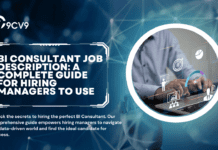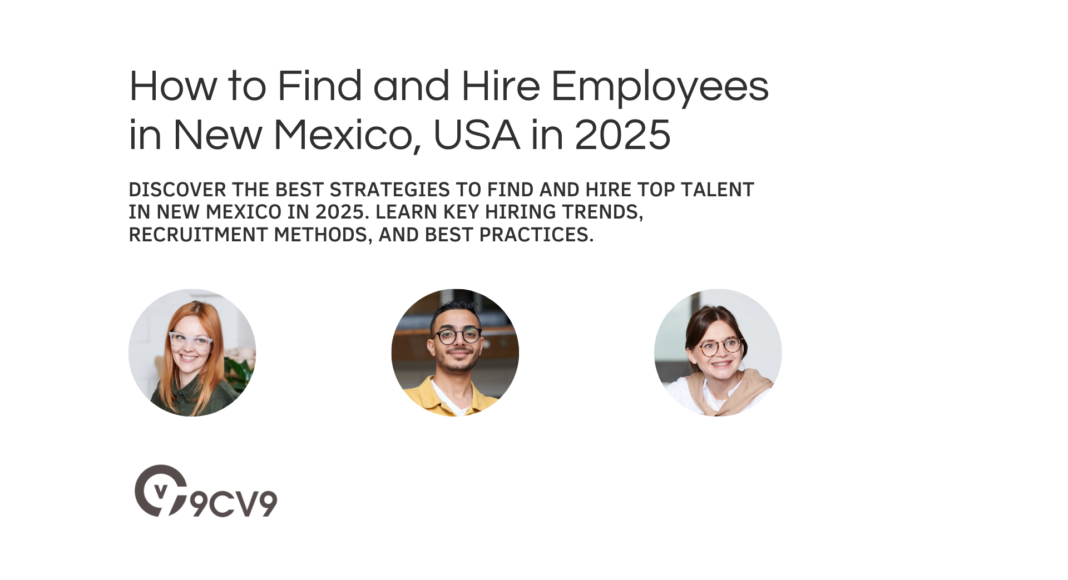Key Takeaways
- Leverage diverse hiring channels – Use job portals like 9cv9, recruitment agencies, and networking platforms to attract top talent in New Mexico.
- Prioritize competitive salaries and benefits – Offer flexible work options, career growth opportunities, and strong compensation packages to stand out.
- Adopt AI-driven recruitment strategies – Streamline candidate sourcing, screening, and selection with data-driven hiring tools for better efficiency.
Finding and hiring employees in New Mexico, USA, has evolved significantly over the past few years, and 2025 brings with it a fresh set of challenges and opportunities for businesses looking to attract top talent.
With an economy that is steadily growing, thanks to key sectors like technology, healthcare, and energy, New Mexico presents a dynamic labor market for employers.
However, businesses must be aware of the latest trends and practices to successfully recruit, hire, and retain employees in this competitive environment.

In 2025, the job market in New Mexico is characterized by a rapidly shifting workforce that embraces both traditional in-office roles and flexible, remote working opportunities.
As businesses continue to adapt to the growing preference for remote work, understanding how to recruit both locally and across state lines has become essential for employers.
At the same time, navigating local economic conditions, understanding the legal framework, and addressing the skills gap remain pivotal in making successful hiring decisions.
This comprehensive guide will explore the best strategies to find and hire employees in New Mexico in 2025, helping you optimize your recruitment process.
We’ll take a deep dive into understanding the current employment trends in the state, offer insight into local job markets, and highlight the most effective methods for recruiting candidates.
Additionally, we will provide expert tips on how to stand out as an employer, ensuring that you attract and retain the best talent for your company’s needs.
Whether you’re a startup looking to build a team or an established business aiming to expand, mastering the art of recruitment in New Mexico will help position your company for long-term success in this evolving economic landscape.
The hiring process is no longer just about filling a vacancy; it’s about finding the right fit for your organization’s goals and culture.
In 2025, the recruitment process must align with changing workforce dynamics, employee expectations, and technological innovations.
By leveraging modern tools and understanding local hiring trends, businesses can ensure they stay ahead of the curve and attract highly qualified candidates in New Mexico.
This guide will walk you through every step of the recruitment journey in New Mexico—from understanding the local employment market to preparing your job listings, optimizing your recruiting methods, and making informed decisions when hiring new employees.
By the end of this article, you will be equipped with the knowledge and insights necessary to build a strong, reliable workforce in 2025 and beyond.
Before we venture further into this article, we would like to share who we are and what we do.
About 9cv9
9cv9 is a business tech startup based in Singapore and Asia, with a strong presence all over the world.
With over nine years of startup and business experience, and being highly involved in connecting with thousands of companies and startups, the 9cv9 team has listed some important learning points in this overview of How to Find and Hire Employees in New Mexico, USA in 2025.
If your company needs recruitment and headhunting services to hire top-quality employees, you can use 9cv9 headhunting and recruitment services to hire top talents and candidates. Find out more here, or send over an email to [email protected].
Or just post 1 free job posting here at 9cv9 Hiring Portal in under 10 minutes.
How to Find and Hire Employees in New Mexico, USA in 2025
- Understanding New Mexico’s Employment Market in 2025
- Preparing for the Hiring Process in New Mexico
- Effective Methods for Finding Talent in New Mexico
- Recruiting for Remote and Hybrid Positions
- How to Stand Out as an Employer in New Mexico
- The Interview Process in New Mexico
- Making the Right Hire in New Mexico
1. Understanding New Mexico’s Employment Market in 2025
In 2025, New Mexico’s employment market is a blend of long-standing economic strengths and emerging opportunities that employers must navigate to successfully recruit talent. Understanding the nuances of the state’s labor market is essential for crafting an effective hiring strategy. This section will provide an in-depth look at the current economic landscape, key employment sectors, and challenges that employers in New Mexico will face when hiring.
Current Economic Overview in New Mexico
- Economic Growth:
- New Mexico’s economy has seen steady growth in recent years, driven by industries such as technology, healthcare, and renewable energy.
- The state’s Gross State Product (GSP) has experienced a positive upward trend, with growth projected to continue into 2025.
- The diversification of the economy has led to a broader range of job opportunities beyond traditional industries like oil and gas, opening new pathways for employers to find skilled workers.
- Unemployment Rates:
- As of 2025, New Mexico’s unemployment rate is lower than the national average, reflecting a tight labor market.
- This low unemployment rate indicates a competitive job market, meaning employers must be proactive in attracting top talent.
- However, certain rural areas of New Mexico still experience slightly higher unemployment rates, especially in counties outside of Albuquerque and Santa Fe.
- Labor Force Participation:
- The state’s labor force participation rate is improving, as more individuals re-enter the workforce, particularly women and older workers.
- However, there remains a notable skills gap, with some employers struggling to find qualified candidates for specialized roles in high-demand sectors like technology and healthcare.
Key Employment Sectors in New Mexico
- Technology and Innovation:
- The technology sector in New Mexico is booming, with significant investments in areas such as software development, IT services, cybersecurity, and AI.
- Albuquerque, the state’s largest city, has seen an influx of tech companies establishing regional offices, including startups and established firms looking to tap into a talented workforce.
- Tech hubs like Santa Fe are also attracting remote workers, with companies providing flexible work options.
- Example: The presence of companies like Los Alamos National Laboratory and Sandia National Laboratories provides a consistent demand for STEM professionals in New Mexico.
- Healthcare:
- Healthcare remains a top sector in New Mexico, driven by an aging population and the need for expanded healthcare services across the state.
- With healthcare employment expected to grow steadily, there is a rising demand for medical professionals, including doctors, nurses, allied health professionals, and technicians.
- New Mexico also ranks high for the recruitment of health IT professionals to manage and improve healthcare data systems.
- Example: The University of New Mexico Health Sciences Center is a major employer and a hub for healthcare innovation in the region.
- Renewable Energy:
- New Mexico’s focus on sustainable energy is creating new jobs in the renewable energy sector.
- The state is investing in wind, solar, and green hydrogen energy, with the aim of becoming a national leader in clean energy.
- Jobs in this sector range from skilled technicians to engineers and project managers.
- Example: The opening of the Luna Energy Facility and ongoing projects by companies like Avangrid and PNM Resources will continue to drive employment growth in the renewable energy sector.
- Tourism and Hospitality:
- Tourism is a significant industry in New Mexico, known for its unique cultural heritage, scenic landscapes, and outdoor recreational opportunities.
- The sector provides thousands of jobs in hospitality, travel, and food services, particularly in areas like Santa Fe, Taos, and Albuquerque.
- With the expected rebound of post-pandemic tourism, hiring in the tourism and hospitality sector is forecast to increase in 2025.
- Example: Hotels, resorts, and cultural institutions in cities like Santa Fe are major employers of both seasonal and full-time workers in hospitality and guest services.
- Education and Research:
- New Mexico’s educational institutions are an integral part of the state’s economy, particularly in higher education and research.
- Universities like the University of New Mexico, New Mexico State University, and Northern New Mexico College serve as major employers and innovation hubs.
- The demand for faculty, administrative staff, and research scientists remains strong, contributing to the state’s overall employment growth.
- Example: The ongoing research initiatives at New Mexico’s national laboratories and universities continue to produce high-paying jobs in both education and research.
Challenges Employers Face in New Mexico
- Skills Gap:
- One of the biggest challenges in New Mexico’s labor market is the skills gap.
- Many employers struggle to find candidates with the advanced technical skills needed in high-demand industries such as IT, healthcare, and renewable energy.
- New Mexico’s education system is working to close this gap, but it remains a hurdle for many businesses looking to fill specialized positions.
- Employers must consider alternative recruitment methods, such as offering additional training or collaborating with local educational institutions to upskill the workforce.
- Attracting Talent to Rural Areas:
- New Mexico’s rural areas, though rich in natural beauty, often face difficulties attracting workers to less populated regions.
- Employers in these areas may need to provide additional incentives, such as relocation packages, remote work options, or competitive salaries to draw in talent.
- For example, tech startups or healthcare providers in rural New Mexico must compete with employers in larger cities by offering appealing benefits and flexible work arrangements.
- Remote Work Trends:
- While remote work offers flexibility, it also creates additional competition for local talent.
- Many businesses in New Mexico are now competing with companies from out-of-state that offer remote positions, requiring local employers to adapt their recruitment strategies.
- Remote work can also make it more challenging for employers to evaluate cultural fit and maintain employee engagement, requiring employers to leverage technology and innovative management practices to manage distributed teams effectively.
- Diversity and Inclusion:
- New Mexico has a diverse population, and creating an inclusive workplace that reflects the state’s cultural richness is a priority for many employers.
- Businesses that fail to address diversity and inclusion may find it harder to attract top talent, particularly younger workers who prioritize workplace equity and social responsibility.
- Employers in New Mexico need to create an inclusive hiring process and foster an environment that welcomes individuals from various backgrounds.
Conclusion: Key Takeaways
- Diverse and Growing Economy:
- New Mexico’s economy offers significant growth potential across various sectors, including technology, healthcare, and renewable energy.
- Employers must tap into these emerging sectors and stay attuned to trends like remote work to remain competitive in 2025.
- Challenges to Overcome:
- Employers should be prepared to face challenges such as the skills gap, rural workforce attraction, and the evolving expectations of remote work.
- Adaptability, flexibility, and a focus on diversity and inclusion will be key in attracting and retaining top talent.
- Proactive Strategies:
- By understanding the state’s economic trends and labor force dynamics, businesses can better position themselves to recruit the right employees, develop a competitive hiring strategy, and maintain a strong workforce in 2025.
2. Preparing for the Hiring Process in New Mexico
Hiring the right employees in New Mexico requires a well-planned strategy that aligns with state regulations, workforce trends, and industry-specific demands. Employers must take a proactive approach in structuring their hiring process to attract and retain top talent in a competitive job market. This section outlines the essential steps businesses should take to prepare for recruitment in New Mexico in 2025.
Understanding Workforce Needs and Job Market Trends
Before launching a hiring campaign, employers must analyze their workforce needs and understand the latest job market trends in New Mexico.
- Assessing Business Growth and Hiring Requirements
- Identify which roles are critical to business expansion and sustainability.
- Determine whether the positions require in-office, hybrid, or fully remote work.
- Forecast future staffing needs based on business objectives, expected retirements, and industry growth trends.
- Example: A growing technology startup in Albuquerque may need more software engineers and cybersecurity experts to support its expansion.
- Identifying High-Demand Skills and Labor Availability
- Research the skills that are in high demand across industries in New Mexico.
- Assess the availability of qualified candidates in the state versus the need for out-of-state recruitment.
- Partner with workforce development programs and universities to tap into emerging talent pools.
- Example: The healthcare industry in Santa Fe is expected to see increased demand for registered nurses and medical technicians, prompting employers to collaborate with nursing schools.
- Monitoring Salary and Compensation Trends
- Conduct market research to determine competitive salaries for various job roles.
- Compare local salary expectations with national trends, especially for remote or hybrid positions.
- Consider offering additional benefits like flexible work arrangements and professional development opportunities.
- Example: Renewable energy companies hiring engineers in New Mexico must ensure compensation aligns with national energy sector standards to attract top talent.
Developing a Comprehensive Job Description
A well-crafted job description plays a crucial role in attracting the right candidates and setting expectations for the role.
- Clearly Define the Role and Responsibilities
- Provide a detailed breakdown of job responsibilities and expectations.
- Highlight how the role contributes to the company’s long-term goals.
- Avoid generic job postings and focus on specific skills and qualifications needed.
- Example: A renewable energy company hiring a solar panel technician should specify required technical skills, certifications, and on-site work expectations.
- Specify Qualifications and Skills Required
- Differentiate between mandatory skills and preferred qualifications.
- Consider soft skills that align with company culture, such as teamwork and adaptability.
- List industry-specific certifications or educational requirements if applicable.
- Example: IT firms hiring cybersecurity professionals may require certifications like CISSP or CISM alongside experience in cloud security.
- Highlight Company Culture and Benefits
- Include details about workplace culture, diversity initiatives, and employee engagement programs.
- List benefits such as healthcare, paid time off, remote work options, and career development programs.
- Provide information on work-life balance policies to attract top talent.
- Example: Companies offering hybrid work models should highlight this in job descriptions to appeal to professionals seeking flexibility.
Complying with New Mexico Employment Laws and Regulations
Employers must ensure their hiring process aligns with local and federal labor laws to avoid legal issues and ensure fair employment practices.
- Understanding Wage and Hour Laws
- Stay updated on New Mexico’s minimum wage requirements and overtime pay regulations.
- Ensure that salary offerings comply with both state and federal labor laws.
- Consider industry-specific wage requirements for fair compensation.
- Example: As of 2025, New Mexico’s minimum wage may be adjusted based on inflation, impacting salary structures for entry-level positions.
- Ensuring Compliance with Anti-Discrimination Laws
- Follow Equal Employment Opportunity (EEO) regulations to prevent discrimination in hiring.
- Avoid biased language in job descriptions that may exclude certain demographics.
- Implement fair recruitment practices, including structured interviews and diverse hiring panels.
- Example: Employers must ensure that job postings do not indirectly discriminate based on age, gender, or ethnicity.
- Conducting Background Checks and Drug Testing
- Understand New Mexico’s laws regarding background checks and permissible inquiries.
- Obtain candidate consent before conducting background screenings.
- Ensure drug testing policies comply with state regulations, especially in industries requiring safety compliance.
- Example: Employers in transportation and healthcare may require pre-employment drug screening for safety-sensitive positions.
Creating an Effective Recruitment Strategy
A structured recruitment strategy ensures that businesses attract and retain high-quality candidates efficiently.
- Choosing the Right Recruitment Channels
- Utilize multiple job platforms, including online job boards, industry-specific networks, and local hiring fairs.
- Leverage professional networks like LinkedIn to reach experienced candidates.
- Engage with workforce development programs and university career centers.
- Example: A construction company may partner with vocational training programs to recruit skilled laborers.
- Leveraging Recruitment Agencies and Staffing Firms
- Work with reputable recruitment agencies specializing in New Mexico’s job market.
- Consider staffing firms for temporary or project-based hiring needs.
- Evaluate agency fees versus in-house recruitment costs for budget efficiency.
- Example: A manufacturing firm looking for specialized machine operators may benefit from working with a local staffing agency.
- Utilizing AI and HR Technology in Hiring
- Implement AI-powered applicant tracking systems (ATS) to streamline candidate screening.
- Use HR analytics tools to assess hiring trends and improve recruitment strategies.
- Automate interview scheduling and resume screening to enhance efficiency.
- Example: AI-driven hiring platforms can help a tech company filter candidates based on relevant skills and experience.
Crafting a Seamless Candidate Experience
A positive candidate experience can enhance an employer’s reputation and improve retention rates.
- Improving Communication and Responsiveness
- Keep candidates informed throughout the hiring process to reduce uncertainty.
- Provide prompt responses to inquiries and follow up after interviews.
- Offer feedback to unsuccessful candidates to maintain a positive employer brand.
- Example: Companies with transparent communication practices see higher offer acceptance rates from top candidates.
- Streamlining the Interview Process
- Structure interviews with clear objectives and standardized questions.
- Offer flexible interview options, including virtual interviews for remote candidates.
- Train hiring managers to conduct fair and unbiased interviews.
- Example: A hybrid workplace should offer both in-person and virtual interview options to accommodate candidates in different locations.
- Enhancing Onboarding and Retention Strategies
- Develop a structured onboarding program to help new hires integrate smoothly.
- Assign mentors or onboarding buddies to improve employee engagement.
- Provide career growth opportunities and ongoing training programs.
- Example: A financial services firm may offer leadership development programs to retain high-potential employees.
Conclusion: Key Takeaways for Employers
- Strategic Preparation is Essential
- Employers must analyze workforce trends, develop competitive job descriptions, and leverage the right recruitment channels.
- A well-planned hiring process helps businesses attract high-quality candidates and minimize turnover.
- Legal Compliance is Critical
- Adhering to New Mexico’s employment laws ensures fair hiring practices and reduces the risk of legal disputes.
- Background checks, wage compliance, and anti-discrimination policies must be integrated into the recruitment process.
- Candidate Experience Impacts Hiring Success
- A streamlined and transparent hiring process enhances employer branding and increases the likelihood of securing top talent.
- Employers should prioritize communication, structured interviews, and robust onboarding programs to build a strong workforce in 2025.
By implementing these best practices, businesses in New Mexico can effectively prepare for the hiring process and secure skilled employees in an evolving job market.
3. Effective Methods for Finding Talent in New Mexico
Finding the right talent in New Mexico requires a strategic approach that aligns with the state’s evolving job market and hiring trends. Employers must leverage multiple recruitment channels, including job portals, recruitment agencies, networking events, and digital hiring strategies, to attract qualified candidates. This section explores the most effective methods for sourcing top talent in New Mexico in 2025.
Leveraging Online Job Portals for Wide Talent Reach
Job portals remain one of the most effective ways to connect with job seekers across New Mexico. These platforms allow employers to post job listings, filter candidates based on qualifications, and streamline the hiring process.
- Utilizing 9cv9 Job Portal for Targeted Hiring
- 9cv9 is a leading job portal that helps businesses connect with skilled professionals in various industries.
- Employers can create detailed job postings with industry-specific filters to attract the right candidates.
- The platform offers AI-driven matching to recommend suitable candidates based on job requirements.
- Example: A software development firm in Albuquerque looking for full-stack developers can use 9cv9’s advanced filtering system to find candidates with expertise in JavaScript and Python.
- Posting Jobs on Local and National Job Boards
- Platforms like Indeed, LinkedIn, and Glassdoor allow businesses to reach a large talent pool.
- Local job portals focused on New Mexico provide access to professionals familiar with the state’s business environment.
- Employers should optimize job postings with clear job descriptions and relevant keywords to enhance visibility.
- Example: A healthcare provider in Santa Fe can post nursing job openings on healthcare-specific job boards to attract licensed medical professionals.
- Using Niche Job Platforms for Industry-Specific Hiring
- Tech companies can use platforms like Stack Overflow Jobs or GitHub Jobs to find software engineers.
- Construction firms can post on industry-focused sites like ConstructionJobs.com.
- Hospitality businesses can use portals like Hcareers to recruit experienced professionals.
- Example: A renewable energy firm in New Mexico looking for solar energy engineers can utilize niche portals to attract specialized candidates.
Partnering with Recruitment Agencies for Professional Talent Acquisition
Recruitment agencies provide expert support in sourcing, screening, and hiring qualified professionals, particularly for specialized roles.
- Working with 9cv9 Recruitment Agency for Comprehensive Hiring Solutions
- 9cv9 Recruitment Agency offers tailored hiring solutions for companies seeking high-quality candidates in New Mexico.
- The agency provides end-to-end recruitment services, including talent sourcing, screening, and interview coordination.
- Employers benefit from a streamlined hiring process that reduces time-to-hire and improves candidate quality.
- Example: A fintech startup in New Mexico looking for experienced data analysts can rely on 9cv9 Recruitment Agency to find candidates with strong analytical skills and industry experience.
- Hiring Through Industry-Specific Recruitment Firms
- Specialized recruitment agencies focus on particular industries, ensuring a better talent fit.
- Tech recruiters can help companies find software developers, cybersecurity experts, and IT managers.
- Manufacturing recruitment agencies assist businesses in sourcing skilled workers for production facilities.
- Example: A medical recruitment agency can help hospitals in New Mexico find certified radiology technicians and licensed physicians.
- Using Staffing Agencies for Temporary and Contract Workers
- Temporary staffing agencies provide businesses with short-term workers for seasonal or project-based roles.
- This method is ideal for industries with fluctuating workforce needs, such as agriculture and tourism.
- Example: A hospitality business in Santa Fe hiring extra staff during the tourism season can work with a staffing agency to onboard temporary employees.
Networking and Employee Referrals for High-Quality Candidates
Personal connections and professional networks can be invaluable in finding top talent in New Mexico.
- Attending Industry Networking Events and Career Fairs
- Local networking events allow employers to connect directly with professionals in their industry.
- Career fairs at universities provide access to fresh graduates eager to enter the workforce.
- Employers can showcase company culture, job opportunities, and career growth prospects.
- Example: A cybersecurity company can participate in tech conferences in Albuquerque to recruit ethical hackers and security analysts.
- Implementing an Employee Referral Program
- Encouraging current employees to refer potential candidates leads to high-quality hires.
- Offering incentives such as bonuses or extra vacation days for successful referrals.
- Referral programs help businesses find candidates who align with company culture.
- Example: A marketing agency in New Mexico can offer employees a $500 referral bonus for successfully hiring a content strategist.
- Engaging with Professional Associations and Trade Groups
- Connecting with industry associations increases access to experienced professionals.
- Groups such as the New Mexico Society of Engineers or the New Mexico Medical Society provide valuable recruitment channels.
- Example: A construction company can join the Associated General Contractors of New Mexico to network with skilled project managers and engineers.
Using Social Media and Digital Hiring Strategies
Social media platforms and digital tools have become essential for modern recruitment.
- Recruiting via LinkedIn and Social Media
- LinkedIn is a powerful tool for reaching passive job seekers and professionals.
- Employers can create job postings, run targeted ads, and engage with potential candidates.
- Social media platforms like Facebook and Twitter help companies promote job openings.
- Example: A financial services firm in New Mexico can use LinkedIn Recruiter to find certified financial analysts.
- Using AI and Data-Driven Hiring Tools
- AI-powered recruitment platforms analyze candidate resumes to match skills with job requirements.
- Automated interview scheduling tools streamline the hiring process and reduce administrative workload.
- Predictive analytics help businesses make data-driven hiring decisions.
- Example: A retail company can use AI-driven hiring tools to filter customer service applicants based on experience and communication skills.
- Leveraging Employer Branding to Attract Top Talent
- Companies should build a strong employer brand to appeal to job seekers.
- Sharing success stories, employee testimonials, and workplace culture insights boosts brand visibility.
- Employers can showcase diversity and inclusion efforts to attract a broader talent pool.
- Example: A renewable energy company can highlight its commitment to sustainability and innovation to attract engineers passionate about green energy.
Collaborating with Universities and Training Programs
Educational institutions provide a pipeline of fresh talent eager to enter the workforce.
- Partnering with Local Universities and Colleges
- Employers can establish internship programs to train students for full-time roles.
- Career services departments help businesses connect with graduates in relevant fields.
- Example: A biotech firm in Santa Fe can collaborate with the University of New Mexico to hire research assistants and laboratory technicians.
- Engaging with Vocational Training and Apprenticeship Programs
- Trade schools and apprenticeship programs provide skilled workers for industries like construction and manufacturing.
- Employers can support workforce development initiatives to bridge the skill gap.
- Example: A construction firm can hire carpenters and electricians trained through New Mexico’s apprenticeship programs.
- Sponsoring Scholarships and Workforce Development Initiatives
- Offering scholarships in high-demand fields helps create a future talent pool.
- Supporting coding bootcamps and technical training programs ensures a skilled workforce.
- Example: A tech company in New Mexico can sponsor scholarships for women in STEM to encourage diversity in the industry.
Conclusion: Key Takeaways for Employers
- Diverse Recruitment Channels Improve Hiring Success
- Using job portals like 9cv9, recruitment agencies, and social media broadens access to top talent.
- Combining traditional networking with digital hiring strategies ensures a well-rounded approach.
- Strategic Partnerships Enhance Workforce Development
- Collaborating with universities, training programs, and trade associations strengthens talent pipelines.
- Employers who invest in local workforce development attract better-qualified candidates.
- Employer Branding and AI Recruitment Tools Boost Hiring Efficiency
- Showcasing company culture and values attracts high-quality professionals.
- Leveraging AI-driven hiring solutions reduces time-to-hire and improves candidate matching.
By implementing these effective hiring strategies, businesses in New Mexico can secure top talent and build a skilled workforce for long-term success.
4. Recruiting for Remote and Hybrid Positions
The shift toward remote and hybrid work models has transformed hiring strategies for businesses in New Mexico. As companies adapt to new workforce dynamics, they must implement effective recruitment methods to attract, evaluate, and retain top talent for flexible work arrangements. This section explores key strategies for recruiting remote and hybrid employees in New Mexico in 2025.
Understanding the Demand for Remote and Hybrid Work in New Mexico
The increasing demand for flexible work options has reshaped the employment landscape in New Mexico. Employers must recognize trends and expectations to design competitive recruitment strategies.
- Growth of Remote and Hybrid Work Models
- The rise of digital transformation has enabled businesses to hire talent beyond geographical constraints.
- Industries such as technology, finance, customer service, and healthcare have seen significant growth in remote roles.
- Hybrid work models allow employees to split their time between office-based and remote work.
- Example: A software development company in Albuquerque allows engineers to work remotely three days a week while collaborating in person on specific projects.
- Employee Preferences for Flexibility
- Surveys indicate that job seekers in New Mexico prioritize flexibility and work-life balance.
- Competitive employers offer remote or hybrid options to attract skilled professionals.
- Work-from-home policies can enhance employee satisfaction and retention.
- Example: A digital marketing agency in Santa Fe offers employees the choice between fully remote work or a hybrid schedule with office access.
- Challenges of Remote and Hybrid Hiring
- Employers face challenges in maintaining productivity, communication, and engagement with remote teams.
- Evaluating remote candidates for collaboration, self-discipline, and technical skills is essential.
- Secure and efficient IT infrastructure is required to support distributed teams.
- Example: A financial services firm in New Mexico invests in cybersecurity training and remote work policies to ensure data protection for off-site employees.
Using Job Portals and Recruitment Agencies for Remote Hiring
Online job portals and professional recruitment agencies provide effective solutions for sourcing remote and hybrid talent in New Mexico.
- Leveraging 9cv9 Job Portal for Remote and Hybrid Roles
- 9cv9 offers job posting features tailored for remote and hybrid work arrangements.
- Employers can filter candidates based on location, skills, and remote work experience.
- AI-driven candidate matching ensures better hiring outcomes.
- Example: A New Mexico-based e-commerce company uses 9cv9 to hire remote customer support representatives across different time zones.
- Partnering with 9cv9 Recruitment Agency for Remote Hiring Solutions
- 9cv9 Recruitment Agency specializes in connecting businesses with pre-screened remote professionals.
- Employers benefit from end-to-end hiring support, including talent sourcing, interviews, and onboarding.
- The agency helps companies implement remote work policies and compliance strategies.
- Example: A tech startup in New Mexico collaborates with 9cv9 Recruitment Agency to hire remote software developers from multiple states.
- Posting on Remote-Specific Job Boards
- Platforms like We Work Remotely, Remote.co, and FlexJobs focus on remote job seekers.
- Employers can attract professionals actively searching for work-from-home opportunities.
- Industry-specific portals help find specialized remote talent.
- Example: A telemedicine company in New Mexico posts remote healthcare job openings on medical-specific job boards.
Evaluating Remote and Hybrid Candidates Effectively
Assessing candidates for remote or hybrid roles requires a structured hiring process that evaluates technical skills, communication abilities, and adaptability.
- Assessing Remote Work Readiness
- Candidates must demonstrate self-motivation, time management, and problem-solving skills.
- Employers should look for prior remote work experience or evidence of independent productivity.
- Behavioral interview questions can reveal a candidate’s ability to work autonomously.
- Example: A project management firm asks candidates to describe how they handle deadlines in a remote setting.
- Using Online Skills Assessments and Technical Tests
- Online coding tests for software developers ensure technical proficiency.
- Writing samples or content creation tasks assess marketing and creative professionals.
- Scenario-based tests evaluate customer service representatives’ problem-solving skills.
- Example: A remote-first IT firm in New Mexico conducts virtual coding challenges to assess developer skills before hiring.
- Conducting Virtual Interviews and Culture Fit Evaluations
- Video interviews help gauge communication skills and professionalism.
- Employers should assess candidates’ ability to collaborate using digital tools like Slack and Zoom.
- Virtual team-building activities can test how candidates interact in a remote work environment.
- Example: A finance company in Albuquerque uses virtual panel interviews to evaluate cultural fit for remote employees.
Onboarding and Managing Remote Employees Successfully
A well-structured onboarding and management process ensures long-term success for remote and hybrid employees.
- Creating an Effective Remote Onboarding Process
- Provide digital onboarding materials, including company policies and training resources.
- Assign mentors or “buddies” to help new hires integrate into remote teams.
- Use video introductions and virtual meetups to foster team connections.
- Example: A New Mexico-based marketing firm hosts virtual coffee chats for new remote hires to build relationships with colleagues.
- Implementing Remote Work Policies and Communication Tools
- Clearly define expectations for work hours, meetings, and deliverables.
- Use collaboration tools like Microsoft Teams, Slack, and Asana for task management.
- Ensure secure access to company systems through VPNs and cybersecurity training.
- Example: A hybrid fintech company in New Mexico uses a centralized digital workspace to streamline communication across remote and in-office employees.
- Maintaining Employee Engagement and Productivity
- Regular virtual check-ins ensure employees feel connected and supported.
- Offer remote team-building activities, wellness programs, and professional development opportunities.
- Recognize and reward top-performing remote employees to boost motivation.
- Example: A fully remote SaaS company in New Mexico organizes virtual happy hours and quarterly retreats to maintain team cohesion.
Navigating Legal and Compliance Considerations for Remote Work
Hiring remote employees involves compliance with local, state, and federal employment regulations.
- Understanding New Mexico’s Remote Work Laws
- Employers must comply with state labor laws, including wage regulations and tax requirements.
- Remote workers in New Mexico are subject to state employment protections and benefits.
- Example: A company hiring remote employees across multiple states must manage tax compliance for different jurisdictions.
- Managing Payroll and Benefits for Remote Workers
- Employers should use HR software to handle multi-state payroll and benefits administration.
- Offering remote-friendly benefits, such as home office stipends and wellness allowances, enhances employee satisfaction.
- Example: A tech firm in Santa Fe provides reimbursement for internet and coworking space memberships for remote employees.
- Ensuring Data Security and Compliance
- Secure remote access policies protect sensitive business information.
- Regular cybersecurity training minimizes risks of data breaches.
- Employers should implement multi-factor authentication and encrypted communication tools.
- Example: A legal firm in New Mexico enforces strict cybersecurity protocols to ensure client confidentiality for remote paralegals.
Conclusion: Key Takeaways for Employers
- Remote and Hybrid Work Models Enhance Talent Acquisition
- Offering flexibility attracts a wider pool of skilled professionals.
- Competitive remote work policies improve employee retention and productivity.
- Optimized Hiring Processes Ensure Success
- Using platforms like 9cv9, recruitment agencies, and remote job boards streamlines talent sourcing.
- Effective candidate assessments and virtual interviews improve hiring decisions.
- Strong Onboarding and Compliance Strategies Are Essential
- Digital onboarding, collaboration tools, and cybersecurity policies ensure smooth operations.
- Adhering to New Mexico’s employment regulations prevents legal complications.
By implementing these strategies, businesses in New Mexico can successfully recruit and manage remote and hybrid employees, ensuring long-term growth and workforce sustainability.
5. How to Stand Out as an Employer in New Mexico
As the job market in New Mexico becomes increasingly competitive, employers must differentiate themselves to attract and retain top talent. A strong employer brand, competitive compensation, and a positive workplace culture are key factors that make companies stand out. In 2025, businesses in New Mexico must go beyond traditional recruitment strategies and embrace innovative approaches to hiring, employee engagement, and workplace development.
Building a Strong Employer Brand
A well-defined employer brand enhances a company’s reputation and attracts high-quality candidates. Businesses must strategically position themselves as desirable employers.
- Showcasing Company Values and Mission
- Employees are drawn to organizations that align with their personal values.
- Clearly define and communicate the company’s mission, vision, and values.
- Promote social responsibility initiatives and sustainability efforts.
- Example: A New Mexico-based renewable energy firm highlights its commitment to environmental sustainability, attracting eco-conscious professionals.
- Developing a Unique Employee Value Proposition (EVP)
- Offer compelling reasons why professionals should work for the company.
- Include competitive benefits, career development opportunities, and workplace culture.
- Example: A tech startup in Albuquerque emphasizes flexible work schedules, remote options, and professional growth programs in its EVP.
- Leveraging Digital and Social Media Presence
- Maintain an engaging careers page with employee testimonials and workplace insights.
- Use LinkedIn, Instagram, and Glassdoor to showcase company culture and employee success stories.
- Example: A healthcare company in Santa Fe shares behind-the-scenes content of employee appreciation events to boost employer branding.
Providing Competitive Compensation and Benefits
Attracting top talent requires offering a strong compensation package that goes beyond salary.
- Ensuring Market-Competitive Salaries
- Conduct salary benchmarking against industry standards in New Mexico.
- Offer performance-based incentives and bonuses.
- Example: A software company in Las Cruces provides salary adjustments based on skills development and project contributions.
- Expanding Employee Benefits and Perks
- Provide comprehensive health insurance, retirement plans, and paid time off.
- Offer unique perks such as student loan assistance, childcare support, and wellness programs.
- Example: A finance firm in Albuquerque provides gym memberships and mental health counseling services for employees.
- Flexible Work Arrangements
- Support remote and hybrid work models to accommodate diverse employee needs.
- Implement compressed workweeks and flexible scheduling.
- Example: A customer service center in Santa Fe allows employees to work a four-day workweek with extended daily hours.
Enhancing Workplace Culture and Employee Engagement
A positive workplace culture fosters higher employee satisfaction and retention.
- Creating an Inclusive and Diverse Workplace
- Implement diversity, equity, and inclusion (DEI) initiatives.
- Encourage employee resource groups (ERGs) for underrepresented communities.
- Example: A manufacturing company in New Mexico offers leadership training for women and minority employees.
- Encouraging Professional Development and Career Growth
- Provide access to skill-building courses, certifications, and mentorship programs.
- Establish internal promotion pathways to retain high-potential employees.
- Example: A hospitality business in Santa Fe offers tuition reimbursement for employees pursuing advanced degrees.
- Recognizing and Rewarding Employee Contributions
- Implement employee recognition programs such as “Employee of the Month” awards.
- Provide incentives such as gift cards, extra paid leave, or professional development stipends.
- Example: A digital marketing agency in Albuquerque celebrates outstanding team members with public acknowledgments and monetary rewards.
Adopting Innovative Hiring and Recruitment Strategies
Companies must modernize their hiring approach to stand out in New Mexico’s competitive job market.
- Leveraging AI-Powered Recruitment Tools
- Use AI-driven job portals like 9cv9 Job Portal to streamline candidate sourcing and screening.
- Implement chatbots and automated interview scheduling to enhance hiring efficiency.
- Example: A logistics company in New Mexico uses 9cv9’s AI-matching features to find the best-qualified candidates for warehouse management roles.
- Partnering with Recruitment Agencies
- Work with specialized firms like 9cv9 Recruitment Agency to access pre-screened talent.
- Utilize recruitment experts to fill niche or high-demand positions.
- Example: A cybersecurity firm in New Mexico partners with 9cv9 to find highly skilled IT professionals for remote positions.
- Hosting Career Fairs and Networking Events
- Participate in local and virtual career fairs to connect with job seekers.
- Organize industry-specific networking events to attract professionals in targeted fields.
- Example: A healthcare provider in Santa Fe hosts annual recruitment fairs to hire nurses and medical technicians.
Implementing Employee Well-Being Programs
A focus on employee well-being improves job satisfaction and productivity.
- Prioritizing Mental Health Support
- Offer access to counseling services and Employee Assistance Programs (EAPs).
- Provide mental health days and stress management workshops.
- Example: A call center in Albuquerque partners with mental health professionals to offer employees free counseling sessions.
- Encouraging Work-Life Balance
- Set boundaries on work-related communications outside office hours.
- Implement paid parental leave and family-friendly policies.
- Example: A law firm in New Mexico allows employees to take extended sabbaticals to focus on personal growth and well-being.
- Creating a Healthy and Safe Work Environment
- Invest in ergonomic office furniture and wellness-friendly workspaces.
- Conduct regular health and safety training for employees.
- Example: A construction company in Santa Fe provides comprehensive safety training and on-site wellness check-ups.
Strengthening Corporate Social Responsibility (CSR) Initiatives
Companies that contribute to their communities build stronger reputations and employee loyalty.
- Engaging in Community Outreach Programs
- Partner with local charities and non-profits for volunteer opportunities.
- Offer paid time off for employees to engage in community service.
- Example: A retail chain in New Mexico organizes food drives and disaster relief programs for local communities.
- Supporting Sustainability and Environmental Initiatives
- Implement eco-friendly business practices such as paperless offices and green energy use.
- Encourage employee participation in sustainability programs.
- Example: A manufacturing company in Albuquerque reduces its carbon footprint by using renewable energy sources in its production facilities.
- Providing Ethical Business Practices and Transparency
- Maintain open communication with employees regarding company policies and decisions.
- Promote fair hiring practices and ethical workplace standards.
- Example: A financial institution in New Mexico releases an annual sustainability and ethics report to maintain transparency with stakeholders.
Conclusion: Establishing a Leading Employer Presence in New Mexico
To stand out as an employer in New Mexico in 2025, businesses must prioritize:
- A strong employer brand that highlights company values, workplace culture, and professional growth opportunities.
- Competitive compensation and benefits to attract and retain top talent.
- An engaging workplace culture that promotes diversity, employee recognition, and well-being.
- Modernized hiring and recruitment strategies, including AI-driven job portals like 9cv9 and partnerships with recruitment agencies.
- Employee well-being programs that enhance work-life balance and mental health support.
- Corporate social responsibility initiatives that strengthen community engagement and sustainability.
By implementing these strategies, companies in New Mexico can position themselves as top employers, attracting the best talent and maintaining a productive, motivated workforce.
6. The Interview Process in New Mexico
The hiring landscape in New Mexico is evolving rapidly, with companies adopting new technologies, remote interviewing practices, and structured evaluation techniques to identify the best talent. Employers must design an efficient and inclusive interview process that ensures a positive candidate experience while meeting business needs. In 2025, job interviews in New Mexico will be shaped by artificial intelligence (AI), data-driven assessments, and hybrid interview formats to improve hiring accuracy and efficiency.
1. Preparing for the Interview Process
A well-prepared interview process ensures smoother execution and a better experience for both employers and candidates.
- Defining the Interview Objectives
- Determine the key skills, competencies, and cultural fit required for the role.
- Establish whether the interview will focus on technical skills, behavioral traits, or both.
- Example: A software company in Albuquerque identifies problem-solving and adaptability as crucial qualities for developers and tailors interview questions accordingly.
- Structuring the Interview Process
- Decide on the number of interview rounds (e.g., initial screening, technical assessment, panel interview).
- Clearly communicate timelines to candidates to manage expectations.
- Example: A healthcare provider in Santa Fe implements a three-step process: phone screening, technical evaluation, and final in-person interview.
- Choosing the Right Interview Format
- Virtual interviews: Conducted via video conferencing for remote roles.
- In-person interviews: Preferred for roles requiring direct team collaboration.
- Hybrid interviews: Combination of virtual and in-person assessments to maximize efficiency.
- Example: A finance company in Las Cruces uses virtual interviews for the first round and in-person meetings for final selections.
2. Conducting the Initial Screening Interview
Screening interviews help filter out unqualified candidates early in the hiring process.
- Phone Screenings
- Typically 15–30 minutes long to assess basic qualifications and interest.
- Questions focus on work experience, salary expectations, and availability.
- Example: A retail company in New Mexico uses phone screenings to shortlist customer service representatives before scheduling in-depth interviews.
- AI-Powered Pre-Screening Assessments
- Automated chatbots and AI-driven tools analyze responses and rank candidates.
- AI-based screening software like 9cv9 Job Portal helps employers shortlist suitable applicants.
- Example: A tech startup in Albuquerque uses 9cv9’s AI screening tool to evaluate coding skills before inviting candidates for live interviews.
- One-Way Video Interviews
- Candidates record their answers to pre-set questions for later review.
- Helps hiring managers evaluate communication skills and professionalism.
- Example: A marketing agency in Santa Fe uses one-way video interviews to gauge candidates’ creativity and presentation skills.
3. Technical and Skill-Based Assessments
Employers use technical evaluations to ensure candidates have the necessary expertise.
- Industry-Specific Assessments
- Coding tests: Used for software developers and IT professionals.
- Case studies: Applied in consulting, finance, and strategic roles.
- Writing samples: Required for marketing, journalism, and content roles.
- Example: A cybersecurity firm in New Mexico administers ethical hacking challenges to assess penetration testing skills.
- Live Technical Interviews
- Conducted via platforms like HackerRank, Codility, or Zoom for coding challenges.
- Allows interviewers to observe problem-solving in real-time.
- Example: A cloud computing company in Santa Fe holds live technical whiteboard sessions for DevOps engineers.
- Situational Judgment Tests (SJT)
- Candidates respond to real-world job scenarios to assess decision-making skills.
- Used for managerial, customer service, and sales positions.
- Example: A hospitality company in New Mexico presents scenarios involving customer complaints to evaluate service-oriented thinking.
4. Behavioral and Cultural Fit Interviews
Behavioral interviews help assess how a candidate would handle real workplace situations.
- STAR Method (Situation, Task, Action, Result)
- Encourages candidates to provide structured responses based on past experiences.
- Used to evaluate leadership, problem-solving, and teamwork abilities.
- Example: A healthcare provider in New Mexico asks candidates how they handled a difficult patient interaction.
- Company Culture and Value-Based Questions
- Ensures candidates align with the company’s mission and work environment.
- Example: A non-profit organization in Albuquerque assesses candidates’ passion for social work by discussing past volunteer experiences.
- Soft Skills Evaluation
- Assesses communication, emotional intelligence, and adaptability.
- Includes role-playing exercises or hypothetical scenarios.
- Example: A real estate firm in Santa Fe tests negotiation skills by having candidates role-play as an agent closing a property deal.
5. Final Rounds and Decision-Making
The final interview rounds involve leadership interviews, salary discussions, and background verification.
- Panel Interviews
- Conducted with multiple interviewers to evaluate candidates from different perspectives.
- Reduces bias and provides a well-rounded assessment.
- Example: A logistics company in Las Cruces uses panel interviews with HR, department heads, and potential team members.
- Executive Interviews
- Senior executives evaluate leadership potential and strategic thinking.
- Used for mid-to-senior management positions.
- Example: A renewable energy company in New Mexico involves the CEO in the final hiring round for high-level engineering roles.
- Salary Negotiations and Offer Discussions
- Employers must offer competitive compensation based on industry benchmarks.
- Example: A fintech company in Santa Fe consults 9cv9 Recruitment Agency to determine market-competitive salaries before making job offers.
- Background Checks and Reference Verification
- Verifies past employment, education, and criminal records if necessary.
- Example: A law firm in New Mexico conducts thorough background checks before hiring legal associates.
6. Enhancing the Candidate Experience
Providing a seamless and engaging interview process improves employer reputation.
- Timely Communication and Transparency
- Keep candidates informed about their application status.
- Example: A technology firm in Albuquerque sends follow-up emails within 48 hours of an interview.
- Reducing Hiring Bias
- Implement structured interviews and standardized scoring rubrics.
- Train interviewers on diversity, equity, and inclusion (DEI) best practices.
- Example: A corporate firm in Santa Fe uses AI-driven blind resume screening to eliminate unconscious bias.
- Providing Constructive Feedback
- Offer personalized feedback to unsuccessful candidates.
- Example: A media company in New Mexico provides detailed interview feedback to content writers who do not progress to final rounds.
7. Future Trends in the Interview Process in New Mexico
Employers must stay ahead of emerging recruitment trends to attract top talent.
- AI-Driven Interview Insights
- AI tools analyze speech patterns, facial expressions, and body language in video interviews.
- Example: A data analytics company in Albuquerque uses AI to detect confidence levels in leadership candidates.
- Virtual Reality (VR) Job Simulations
- Provides immersive experiences for candidates to showcase their skills.
- Example: A construction company in Santa Fe uses VR to test architects’ ability to design complex structures.
- Gamification of Interviews
- Engages candidates through interactive assessments and challenges.
- Example: A digital marketing firm in New Mexico creates an online simulation where candidates design a viral ad campaign.
Conclusion: Optimizing the Interview Process for 2025
To ensure successful hiring in New Mexico in 2025, employers must:
- Adopt AI-driven screening tools like 9cv9 Job Portal to streamline candidate selection.
- Utilize a mix of virtual, hybrid, and in-person interviews to accommodate modern workforce needs.
- Implement technical and soft skills assessments to evaluate candidates effectively.
- Enhance the candidate experience by improving communication, reducing bias, and providing feedback.
- Stay updated on emerging trends like AI-powered insights, VR job simulations, and gamified interviews.
By embracing these strategies, companies in New Mexico can build an efficient, engaging, and future-ready interview process that attracts the best talent in 2025 and beyond.
7. Making the Right Hire in New Mexico
Hiring the right talent is crucial for business success, and in 2025, companies in New Mexico must adapt to evolving workforce trends, technology advancements, and industry demands. A structured and strategic hiring process ensures organizations attract, assess, and onboard employees who align with business goals and company culture.
Employers need to leverage data-driven recruitment strategies, AI-powered tools, and inclusive hiring practices to make the right hire. This section explores key considerations for hiring in New Mexico in 2025, covering best practices, screening methods, selection criteria, and emerging trends.
1. Understanding the Hiring Landscape in New Mexico
The job market in New Mexico is influenced by several factors, including industry demands, workforce availability, and economic conditions.
- Growing Industries in New Mexico
- Technology and IT: Software development, cybersecurity, and data analytics roles are in high demand.
- Healthcare: Increased need for nurses, medical technicians, and healthcare administrators.
- Renewable Energy: Rising investments in solar and wind energy are creating job opportunities.
- Manufacturing and Logistics: Growth in supply chain management and industrial automation.
- Example: A solar energy company in Albuquerque is expanding its workforce to support large-scale renewable energy projects.
- Challenges in Hiring
- Talent Shortages: Competition for skilled professionals in high-growth industries.
- Remote Work Preferences: Many candidates seek flexible and hybrid work arrangements.
- Retention Issues: Companies must focus on long-term engagement strategies to reduce turnover.
- Example: A tech startup in Santa Fe struggles to retain software developers due to remote job offers from out-of-state companies.
2. Defining the Ideal Candidate Profile
A clear understanding of the ideal hire helps businesses streamline their recruitment process.
- Skills and Qualifications Assessment
- Identify essential hard skills (e.g., technical proficiency, certifications).
- Evaluate soft skills (e.g., communication, leadership, adaptability).
- Example: A cybersecurity firm in New Mexico prioritizes candidates with CompTIA Security+ and Certified Ethical Hacker (CEH) certifications.
- Cultural Fit and Organizational Alignment
- Assess alignment with company values and mission.
- Consider work ethic, collaboration style, and adaptability.
- Example: A non-profit organization in Albuquerque seeks candidates who are passionate about social impact and community development.
- Growth Potential and Long-Term Contribution
- Look for candidates with leadership potential and willingness to upskill.
- Assess long-term career aspirations and commitment.
- Example: A healthcare provider in Santa Fe hires nurses who are interested in leadership development programs.
3. Leveraging AI and Data-Driven Recruitment
In 2025, AI-powered tools and analytics play a significant role in making better hiring decisions.
- AI-Driven Candidate Screening
- AI tools analyze resumes and rank candidates based on job fit.
- Reduces bias and speeds up shortlisting.
- Example: A retail company in Las Cruces uses 9cv9’s AI recruitment platform to filter top candidates.
- Predictive Analytics in Hiring
- Uses historical data to predict candidate success and retention rates.
- Helps in reducing hiring mistakes and turnover.
- Example: A finance firm in New Mexico utilizes predictive analytics to identify candidates who perform well in high-pressure roles.
- Automated Skill Assessments
- Online tests evaluate technical and cognitive skills.
- AI generates insights on problem-solving abilities and decision-making.
- Example: A software development company in Albuquerque conducts automated coding challenges to assess programming skills.
4. Conducting Effective Interviews
Structured interviews ensure objective candidate evaluation and better hiring decisions.
- Behavioral Interview Techniques
- Uses the STAR (Situation, Task, Action, Result) method for assessing past experiences.
- Example: A logistics company in Santa Fe asks candidates how they handled supply chain disruptions in previous roles.
- Structured vs. Unstructured Interviews
- Structured Interviews: Standardized questions for consistent evaluation.
- Unstructured Interviews: Free-flowing discussions to assess personality and cultural fit.
- Example: A digital marketing agency in Albuquerque uses structured interviews for technical skills and unstructured discussions for creativity assessment.
- Panel and Multi-Stage Interviews
- Includes multiple interviewers to reduce bias and improve decision-making.
- Helps evaluate candidates from different perspectives.
- Example: A healthcare facility in New Mexico conducts three rounds—HR screening, technical evaluation, and final leadership interview.
5. Assessing Soft Skills and Emotional Intelligence
Beyond technical qualifications, soft skills and emotional intelligence (EQ) are critical for workplace success.
- Communication and Collaboration
- Evaluate how well candidates articulate ideas and engage in teamwork.
- Example: A customer service role in Santa Fe requires strong interpersonal skills for handling client inquiries.
- Adaptability and Problem-Solving
- Assess how candidates handle change and unexpected challenges.
- Example: A manufacturing company in Albuquerque presents candidates with real-world production issues to evaluate their problem-solving approach.
- Leadership and Initiative
- Identify candidates with leadership potential and proactive thinking.
- Example: A financial services firm in New Mexico looks for analysts who take initiative in optimizing investment strategies.
6. Making the Final Hiring Decision
Once interviews and assessments are complete, companies must make data-driven hiring decisions.
- Comparing Candidate Performance
- Review interview scores, skill assessments, and cultural fit evaluations.
- Use a weighted scoring system for objective comparisons.
- Example: A legal firm in Santa Fe assigns numerical scores to technical knowledge, problem-solving, and leadership traits.
- Checking References and Backgrounds
- Verify previous work experience, education credentials, and professional references.
- Ensure compliance with industry regulations and legal requirements.
- Example: A government agency in New Mexico conducts in-depth background checks for security clearance positions.
- Negotiating Salary and Benefits
- Offer competitive compensation based on market benchmarks.
- Highlight perks such as remote work options, career development, and wellness programs.
- Example: A startup in Albuquerque provides stock options and flexible work schedules to attract top-tier developers.
7. Enhancing Employee Onboarding and Retention
A strong onboarding process improves employee retention and long-term job satisfaction.
- Comprehensive Onboarding Programs
- Provide structured training and mentorship opportunities.
- Introduce company culture, mission, and expectations.
- Example: A renewable energy company in Santa Fe has a six-week onboarding program that includes site visits, mentorship, and leadership training.
- Employee Engagement and Career Growth
- Offer continuous learning opportunities and career development plans.
- Encourage feedback and open communication between employees and management.
- Example: A healthcare organization in New Mexico provides tuition reimbursement for nurses pursuing advanced certifications.
- Retention Strategies and Workplace Culture
- Focus on employee well-being, work-life balance, and recognition programs.
- Conduct regular check-ins and employee satisfaction surveys.
- Example: A tech company in Albuquerque implements DEI (Diversity, Equity, and Inclusion) programsto foster an inclusive workplace.
8. Future Hiring Trends in New Mexico
Staying ahead of recruitment trends ensures businesses attract top talent.
- Remote and Hybrid Hiring
- More companies will offer flexible work arrangements to remain competitive.
- Example: A digital marketing firm in Santa Fe hires remote designers from across the U.S. to access a broader talent pool.
- AI-Driven Job Matching
- AI tools will improve candidate-job matching accuracy using deep learning algorithms.
- Example: Recruitment agencies in New Mexico use 9cv9’s AI-powered job matching to streamline hiring.
- Diversity and Inclusion-Focused Hiring
- More businesses will implement structured DEI hiring practices.
- Example: A corporate firm in Albuquerque prioritizes diverse hiring panels to ensure unbiased hiring decisions.
Conclusion: Building a Strong Workforce in New Mexico
To make the right hire in 2025, companies in New Mexico must:
- Leverage AI and predictive analytics for data-driven recruitment.
- Prioritize skills, cultural fit, and long-term potential in hiring decisions.
- Implement structured interviews and soft skills assessments to evaluate candidates effectively.
- Focus on onboarding, retention, and workplace culture to reduce turnover.
By adopting these strategies, businesses can attract and retain top talent, ensuring long-term success in the evolving job market of New Mexico.
Conclusion
Finding and hiring the right employees in New Mexico in 2025 requires a strategic approach that aligns with evolving job market trends, industry demands, and technological advancements. Employers must adapt to new hiring challenges while leveraging innovative recruitment strategies to attract and retain top talent. A successful hiring process goes beyond filling vacancies—it ensures that businesses build a skilled, engaged, and productive workforce capable of driving long-term growth.
New Mexico’s employment landscape continues to evolve, with industries such as technology, healthcare, renewable energy, and logistics experiencing significant growth. The competition for skilled professionals remains intense, making it essential for employers to adopt proactive hiring strategies. By incorporating AI-driven recruitment tools, expanding sourcing channels, and prioritizing diversity and inclusion, companies can position themselves as top employers in the region.
Key Takeaways for Effective Hiring in New Mexico
To streamline the hiring process and secure the best candidates, businesses should focus on:
- Understanding the Local Job Market
- Analyze workforce trends and skill availability in key industries.
- Identify in-demand roles and salary benchmarks to stay competitive.
- Example: A renewable energy firm in Santa Fe ensures competitive salaries to attract top engineers.
- Leveraging AI and Data-Driven Recruitment
- Use AI-powered tools for resume screening, skill assessments, and job matching.
- Implement predictive analytics to improve hiring success and retention rates.
- Example: A finance company in Albuquerque uses AI-driven talent acquisition platforms to streamline candidate selection.
- Expanding Recruitment Channels
- Utilize job boards, recruitment agencies, and networking platforms to reach diverse talent pools.
- Engage in university partnerships and job fairs to attract emerging talent.
- Example: A healthcare facility collaborates with the University of New Mexico to recruit nursing graduates.
- Conducting Structured and Fair Interviews
- Implement competency-based and behavioral interview techniques to assess candidates effectively.
- Reduce hiring biases by using standardized evaluation criteria.
- Example: A tech startup in Las Cruces uses structured technical assessments to evaluate coding skills objectively.
- Assessing Skills, Cultural Fit, and Growth Potential
- Focus on hard skills, soft skills, and adaptability in fast-changing industries.
- Prioritize candidates who align with company values and long-term objectives.
- Example: A logistics company in New Mexico hires supply chain managers with strong problem-solving and leadership abilities.
- Offering Competitive Salaries and Benefits
- Provide attractive compensation packages that include work-life balance incentives.
- Highlight career growth opportunities, professional development programs, and wellness initiatives.
- Example: A corporate firm in Albuquerque introduces hybrid work models to attract remote talent.
- Enhancing Onboarding and Employee Retention
- Develop structured onboarding programs to integrate new hires effectively.
- Foster an inclusive workplace culture that values diversity, equity, and employee engagement.
- Example: A digital marketing agency in Santa Fe implements mentorship programs to improve retention.
Future Trends Shaping Hiring in New Mexico
The hiring process in 2025 will continue to be influenced by technological advancements, economic shifts, and changing workforce expectations. Some emerging trends to watch include:
- Increased Adoption of Remote and Hybrid Work Models
- More companies will embrace remote and hybrid work structures to attract a broader talent pool.
- Example: A software development company in New Mexico hires developers from across the U.S. while maintaining an Albuquerque headquarters.
- AI-Driven Job Matching and Candidate Analysis
- Artificial intelligence will further refine hiring decisions by improving job-candidate compatibility.
- Example: Recruitment firms in New Mexico integrate AI to predict candidate success based on performance metrics.
- Diversity, Equity, and Inclusion (DEI) Initiatives
- Companies will continue to prioritize DEI-focused recruitment practices to foster workplace inclusivity.
- Example: A financial institution in Santa Fe implements blind resume screening to minimize hiring bias.
- Skills-Based Hiring Over Degree-Based Requirements
- Employers will place greater emphasis on hands-on skills and certifications rather than traditional degrees.
- Example: A cybersecurity firm in New Mexico prioritizes applicants with industry certifications over formal academic qualifications.
Final Thoughts: Strengthening Recruitment Strategies for Long-Term Success
To thrive in the competitive hiring landscape of New Mexico in 2025, businesses must adopt a future-ready recruitment approach. By leveraging AI-powered tools, expanding talent acquisition channels, and fostering an inclusive workplace culture, companies can build high-performing teams that drive innovation and business growth.
Employers should continuously refine their hiring processes by staying informed about industry trends, workforce expectations, and best practices. A data-driven and employee-centric approach to recruitment not only enhances hiring success but also improves retention, productivity, and overall workplace satisfaction.
As the job market in New Mexico continues to evolve, organizations that prioritize strategic hiring, professional development, and employee well-being will position themselves as industry leaders. Investing in a strong recruitment framework today will ensure long-term business success and workforce stability in the years to come.
If you find this article useful, why not share it with your hiring manager and C-level suite friends and also leave a nice comment below?
We, at the 9cv9 Research Team, strive to bring the latest and most meaningful data, guides, and statistics to your doorstep.
To get access to top-quality guides, click over to 9cv9 Blog.
People Also Ask
How can I find skilled employees in New Mexico in 2025?
Use job portals like 9cv9, recruitment agencies, networking events, and social media platforms to connect with qualified candidates in New Mexico.
What are the best job portals for hiring in New Mexico?
Platforms like 9cv9, Indeed, LinkedIn, and local job boards are highly effective for sourcing top talent in New Mexico.
How do I attract top talent in New Mexico?
Offer competitive salaries, flexible work options, career growth opportunities, and strong company culture to attract the best candidates.
What industries are hiring the most in New Mexico in 2025?
Healthcare, technology, manufacturing, and energy sectors are experiencing high demand for skilled professionals.
How can I optimize job postings for better hiring results?
Use clear job descriptions, include salary ranges, highlight benefits, and optimize job titles with relevant keywords for SEO visibility.
What are the benefits of using a recruitment agency in New Mexico?
Recruitment agencies like 9cv9 streamline hiring, provide access to a larger talent pool, and ensure candidates match job requirements.
How do I conduct an effective job interview in New Mexico?
Prepare structured interview questions, assess both technical and soft skills, and provide a welcoming candidate experience.
What legal considerations should I be aware of when hiring in New Mexico?
Ensure compliance with federal and state labor laws, including minimum wage, work permits, and anti-discrimination regulations.
How do I recruit remote employees in New Mexico?
Utilize remote job boards, virtual interviews, and digital collaboration tools to effectively hire and manage remote employees.
What salary expectations do job seekers have in New Mexico in 2025?
Salary expectations vary by industry but offering competitive pay, benefits, and incentives is key to attracting top talent.
How can I improve my employer brand in New Mexico?
Showcase a positive workplace culture, offer employee testimonials, maintain an active online presence, and provide career growth opportunities.
What hiring trends are shaping New Mexico’s job market in 2025?
AI-driven recruitment, hybrid work models, and skills-based hiring are among the top trends influencing the hiring landscape.
Where can I find entry-level employees in New Mexico?
Partner with local universities, vocational schools, and internship programs to access fresh talent entering the workforce.
How do I retain employees in New Mexico?
Provide career development opportunities, competitive compensation, work-life balance, and a positive company culture.
What are the challenges of hiring in New Mexico?
Talent shortages in specialized industries, increasing competition, and evolving workforce expectations are common challenges.
How do I write a compelling job description for hiring in New Mexico?
Clearly outline job responsibilities, qualifications, salary range, and benefits while using engaging and inclusive language.
What are the most in-demand skills in New Mexico’s job market?
Technical skills in IT, engineering, healthcare, and renewable energy, as well as soft skills like communication and adaptability.
How can small businesses compete for top talent in New Mexico?
Offer unique perks such as flexible schedules, career growth opportunities, and strong company culture to attract top candidates.
What are the best social media platforms for recruiting in New Mexico?
LinkedIn, Facebook, and Twitter are effective for engaging with job seekers and promoting job openings.
How can AI improve the hiring process in New Mexico?
AI tools streamline resume screening, automate interview scheduling, and provide data-driven hiring insights.
What benefits should I offer to attract employees in New Mexico?
Health insurance, remote work options, paid time off, retirement plans, and professional development opportunities.
How do I recruit for hybrid positions in New Mexico?
Clearly define remote and in-office expectations, use digital collaboration tools, and offer flexibility in work arrangements.
What is the hiring outlook for New Mexico in 2025?
The job market remains competitive, with growth in industries like tech, healthcare, and renewable energy driving demand for skilled workers.
How can I speed up the hiring process in New Mexico?
Streamline applications, use recruitment software, conduct virtual interviews, and simplify decision-making processes.
What recruitment strategies work best for startups in New Mexico?
Leverage networking events, referral programs, social media hiring, and job portals like 9cv9 to find top talent.
How do I ensure diversity and inclusion in my hiring process?
Use inclusive job descriptions, expand outreach to diverse talent pools, and implement unbiased hiring practices.
What are the best employee retention strategies in New Mexico?
Foster a positive work culture, provide career development, recognize employee achievements, and offer competitive pay.
How do I find temporary or seasonal workers in New Mexico?
Use staffing agencies, gig work platforms, and seasonal job fairs to recruit temporary employees efficiently.
How can 9cv9 help businesses hire in New Mexico?
9cv9 provides access to a vast talent pool, AI-driven recruitment tools, and expert hiring support to streamline the hiring process.































![Writing A Good CV [6 Tips To Improve Your CV] 6 Tips To Improve Your CV](https://blog.9cv9.com/wp-content/uploads/2020/06/2020-06-02-2-100x70.png)


